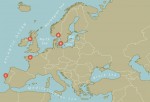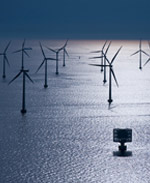
Renewable energies
-
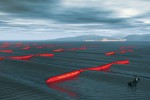
7.12 c > The Pelamis wave energy transformer floats on the ocean like a giant sea snake. It consists of several segments which move against each other and build up hydraulic pressure. This in turn drives a turbine. A new Pelamis generation is currently under construction.
An unretrieved treasure trove
The oceans are teeming with energy. Tidal forces move immense masses of water. Strong winds build up mighty waves. Almost 90 per cent of global wind energy is contained in the turbulence above the world’s oceans. Wind, waves and currents together contain 300 times more energy than humans are currently consuming. For a long time, this abundance went untapped. In recent years, however, we have begun to harness this energy. The first offshore wind farms were built. Hundreds of power plants have been and are being built to convert ocean current and wave energy to electricity. The key renewable marine energies are:- Wind energy
- Wave energy
- Tidal energy
- Ocean current energy
- Energy derived from temperature differences at various ocean depths (ocean thermal energy conversion – OTEC)
- Energy derived from the different salt content of freshwater and saltwater (osmotic power)
Many of the potential locations in coastal areas can be ruled out because they are either reserved for the fishing industry, reserved for shipping, or they are protected areas. All the same, these renewable energies could still meet a significant share of the world’s energy needs in future.
-
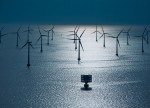
7.12 e > Offshore wind turbines produce electricity in many places around the world. One of the largest offshore wind farms, consisting of 48 turbines, is located in the Baltic Sea between Denmark and Sweden. A transformer station has been constructed here to feed power into the Swedish grid.
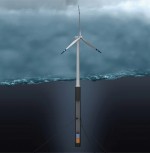
7.13 > Wind turbines are normally erected at a maximum water depth of 45 metres; otherwise, the cost of the towers is prohibitive. One alternative is to anchor floating turbines to the sea bed with holding cables. The first prototypes are currently being tested.
Offshore wind
Wind energy is currently at the most advanced stage of development, and the signs are extremely promising. Experts estimate that offshore wind power alone could in future supply about 5000 terawatt-hours (TWh) of electricity a year worldwide – approximately a third of the world’s current annual electricity consumption of about 15,500 terawatt-hours (1 terawatt-hour = 1 trillion watts). It is anticipated that offshore wind energy plants (WEPs) alone in Europe will supply about 340 terawatt-hours a year by 2015. About 40 offshore wind energy projects have so far been implemented worldwide, most of them in the United Kingdom, Denmark, the Netherlands and Sweden. Two trends are clear. One, that the facilities are getting bigger all the time, and two, that we are constantly venturing into deeper waters, which will allow the construction of wind farms over far greater areas. Whereas at the beginning of this century we were building in coastal areas at depths of 2 to 6 metres, wind turbine towers are now anchored to the ocean floor at depths of more than 40 metres.
Floating offshore concepts are also being developed for even deeper waters. The world’s first floating wind energy plant was recently constructed off the coast of Norway by a Norwegian-German consortium. Backed by the experience of hundreds of thousands of onshore WEPs, wind energy has become a mature technology. The high wind speeds and harsh environmental conditions at sea, however, mean that some technological improvements are required, a fact borne out by the problems encountered by the first large-scale wind farm in Denmark. For this reason only twelve wind turbines from different manufacturers were initially built and tested at Germany’s first offshore wind farm “Alpha Ventus”. Located in the North Sea about 40 kilometres off the island of Borkum, the farm was sponsored by the German Federal Ministry of Economics.
Offshore plant is still considerably more expensive to construct than onshore due to the challenging foundation work and complicated connection to the power grid. Nonetheless, according to experts, offshore wind energy, supported by feed-in payments and support measures, will continue to grow substantially in the coming years.
Wave energy
The global technical potential of wave energy is estimated at 11,400 TWh per year. Its sustainable generating potential of 1,700 TWh per year equates to about 10 per cent of global energy needs. There are various different concepts for generating power from wave energy, most of which can be classified in three basic types:- The “Oscillating Water Column” principle: Wave action causes water to move up and down in an air-filled chamber. The air is displaced and forced through a turbine which generates electricity. Pilot plants of this type were set up in recent years in Portugal, Scotland and Japan.
- The “Oscillating Bodies” principle: Facilities of this type use the motion of ocean waves to generate electricity. They include semi-submerged generators on which a float on a fixed counterbearing moves either sideways or up and down. Other systems consist of flexible mounted components that move against each other, putting hydraulic oil under pressure. The oil in turn drives a turbine. Recently, the British “Pelamis” system, a type of sea snake composed of several segments that float on the water’s surface, created quite a stir. Pelamis, the world’s first wave energy system, was established off the coast of Portugal in 2008 and is connected to the power grid by an undersea cable. Similar farms are planned in Spain and Portugal.
- The “Overtopping” principle: Similar to a dam, overtopping devices have a reservoir that is filled by incoming waves to levels above the surrounding ocean. The energy of the water falling back to the ocean is used to drive a turbine. Prototypes of both floating and fixed systems have already been installed in Denmark and Norway.
 7.12 a > Power plants designed to harness ocean energy are already operating at several sites in Europe. The oldest is La Rance tidal power station near St. Malo in France, which was built in the 1960s. For many years it was the largest of its kind, with an output of 240 megawatts.
7.12 a > Power plants designed to harness ocean energy are already operating at several sites in Europe. The oldest is La Rance tidal power station near St. Malo in France, which was built in the 1960s. For many years it was the largest of its kind, with an output of 240 megawatts.Tidal energy
Tidal power plants work in a similar way to power plants at a reservoir – except that the water masses do not flow downhill but are moved back and forth with tidal flows. Unlike other forms of ocean energy, tidal energy has been utilized commercially for some time. The La Rance tidal power station began operations in 1966 at St. Malo on the Atlantic coast in northern France, where the La Rance River flows into the sea. At high tide the water flows upstream through the large turbines of the power station, and at low tide it flows downstream again. The 240 megawatt (MW) power station (1 megawatt = 1 million watts) has a similar output to a gas-fired power station. Similar facilities have been constructed in Canada, China and Russia over the past 20 years, although these are considerably smaller. A 260 MW tidal power station integrated in an existing dam is scheduled to come on-stream in South Korea this year.
The United Kingdom has been planning to construct a major tidal power station at the estuary of the River Severn between England and Wales for some time. The location could supply enough energy to meet 7 per cent of the United Kingdom’s entire power needs. However, critics fear that the construction of the dams could devastate vital nature reserves and bird sanctuaries. The environmental damage could be substantial. For this reason alternative concepts and locations are now being discussed.
-
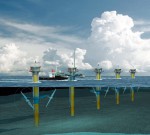 7.12 b > Tidal energy can be converted to electricity by underwater rotors, as at the SeaGen plant off the coast of Northern Ireland in Strangford Lough. One facility has already been constructed which feeds electricity into the grid onshore. Others will follow.
7.12 b > Tidal energy can be converted to electricity by underwater rotors, as at the SeaGen plant off the coast of Northern Ireland in Strangford Lough. One facility has already been constructed which feeds electricity into the grid onshore. Others will follow. Ocean current energy
Ocean current energy can also be harnessed using submerged rotors which are driven by the motion of the water. It has been estimated that ocean current power stations and tidal power plants together could harness several 100 terawatt-hours of electricity per year worldwide.
For some time now tests have been carried out on some rotor concepts, such as the Seaflow system, the prototype of which commenced operations off the English coast in 2003. Its successor, SeaGen, is now rotating in the Strangford Narrows off the Irish coast. Under this concept two rotors are mounted on the tower of the plant. This increases the electricity yield and balances out the high construction and start-up costs.
Such ocean facilities face much harsher stresses from currents and wave movements than wind turbines, for example, and for this reason extensive endurance testing is called for. Nonetheless, the SeaGen technology is closely based on the wind turbine model. The blade angle and rotational speed can be adjusted to suit the prevailing current. Other concepts focus on fixed, non-adjustable systems.
Energy derived from temperature differences
Ocean thermal energy conversion (OTEC) utilizes the temperature difference between warm surface water and cold deep water to generate power. In order to drive the steam cycle in an OTEC power station, the temperature difference must be at least 20 degrees Celsius. The technology is therefore more suited to warmer marine regions. The warm water is used to evaporate a liquid which boils at low temperatures, producing steam which drives a turbine. Cold seawater (4 to 6 degrees) is then pumped up from a depth of several 100 metres and used to cool and condense the steam back to liquid form.
Until now the cost of OTEC technology has been considered prohibitive, requiring pipelines of several 100 metres in length and powerful pumping systems. The US government supported OTEC development and initial testing in the mid 1970s, but withdrew its funding in the early 1980s. Interest in the technology has recently been rekindled, however. An American-Taiwanese consortium is now planning to construct a 10 MW facility in Hawaii. Furthermore, public institutions and businesses in France have launched the IPANEMA initiative, which aims to promote both ocean-based renewable energies and OTEC technology. It is estimated that OTEC has the potential to harness several 1000 TWh of electric power each year. Unlike wind and wave energy, this form of electricity production is not subject to fluctuating weather conditions.
-
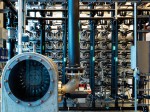 7.12 d > The world’s first osmotic power plant on the Oslo Fjord in Norway derives energy from the differences in salt concentration between saltwater and freshwater. A thin membrane separates the water masses, building up pressure which drives a turbine.
7.12 d > The world’s first osmotic power plant on the Oslo Fjord in Norway derives energy from the differences in salt concentration between saltwater and freshwater. A thin membrane separates the water masses, building up pressure which drives a turbine. Energy derived from the different salt content of freshwater and saltwater
The osmotic power plant is an entirely new way of generating energy. It exploits the osmotic pressure which builds up between freshwater and saltwater when they are pumped into a double chamber and separated by a special semi-permeable membrane. The technology is still in its infancy. In 2009, however, members of a Norwegian syndicate constructed the world’s first osmotic power station on the Oslo Fjord. The plant is designed principally to develop this technology, at present generating only a few kilowatts of electricity. However, the sustainable global production capacity of osmotic power could in future amount to 2000 TWh annually.
Government support for the energy systems of the future
There is no doubt that major advances have been made in developing technologies to harness renewable energy from the oceans. Although many technologies show commercial promise, however, virtually all of them depend on subsidies because they are driven by small, young businesses. Apart from the technological and economic risk, one difficulty is to achieve project sizes which would make such investment viable. Subsidies for these technologies are therefore essential. Various nations offer such programmes. The US Department of Energy and the European Union are already investing several 100 million euros in their development. The complex approval procedures for plants and grid connections also need to be simplified. In Germany the approval of offshore wind plant is entirely in the hands of the Federal Maritime and Hydrographic Agency, but in the USA plant operators must battle their way through various agencies and approval processes. Relaxing the rules would be of great benefit.
